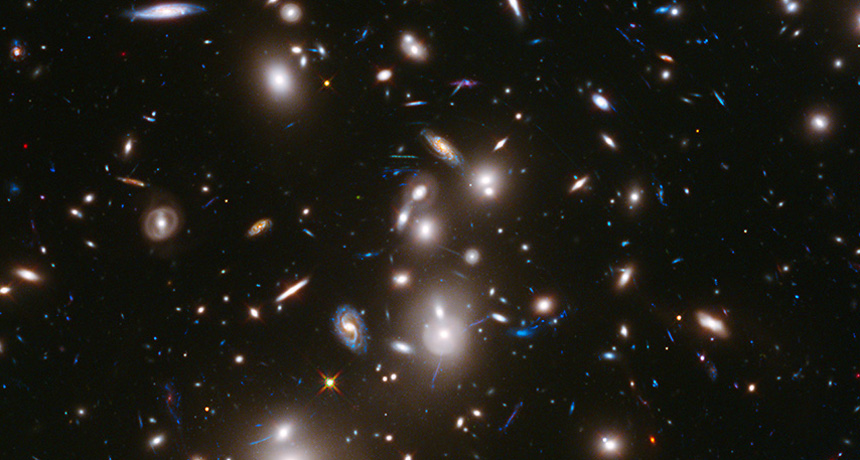Faint, distant galaxies may have driven early universe makeover

Two cosmic magnifying glasses are giving astronomers a glimpse of some extremely faint galaxies that existed as far back as 600 million years after the Big Bang (13.8 billion years ago). Such views suggest that tiny galaxies in the early universe played a crucial role in cosmic reionization — when ultraviolet radiation stripped electrons from hydrogen atoms in the cosmos.
“That we detected galaxies as faint as we did supports the idea that a lot of little galaxies reionized the early universe and that these galaxies may have played a bigger role in reionization than we thought,” says Rachael Livermore, an astronomer at the University of Texas at Austin. She and colleagues report the results in the Feb. 1 Astrophysical Journal.
The team identified the dim galaxies in images taken with the Hubble Space Telescope while it was pointed at two closer clusters of galaxies. Those clusters act as a gravitational lens, brightening and magnifying the light of fainter objects much farther away. Subtracting the clusters’ light revealed distant galaxies up to one-tenth as bright as those spotted in previous studies (SN Online: 11/4/15).
Finding such faint galaxies implies that stars can form in much smaller galaxies than models have predicted and that there were enough of these small galaxies to drive reionization almost entirely by themselves. Reionization radically refashioned the universe so that charged atoms instead of neutral ones pervaded space. Understanding that transition may help astronomers explain how stars and galaxies arose in the early universe.
“Such measurements are really challenging to make,” says Brant Robertson, an astronomer at the University of California, Santa Cruz, who was not involved with the study. “They’re really at the forefront of this field, so there are some questions about the techniques the team used to detect these galaxies and determine how bright they actually are.”
A team of astronomers led by Rychard Bouwens of Leiden University in the Netherlands argues in a paper submitted to the Astrophysical Journal and posted October 2 online at arXiv.org that Livermore and colleagues haven’t, in fact, detected galaxies quite as faint as they have claimed. That keeps the door open for other objects, such as black holes accreting matter and spitting out bright light, to have played a part in reionization.
Robertson says the disagreements motivate further work, noting that Livermore and colleagues used a clever approach to spot what appear to be superfaint galaxies in the early universe. Now, the teams will have to see if that technique stands the test of time.
Livermore and colleagues plan to use the technique to search for faint galaxies lensed by other clusters Hubble has observed. Both teams, along with Robertson, are also looking to the October 2018 launch of the James Webb Space Telescope, which should be able to spot even fainter and more distant galaxies, to determine what drove reionization in the early universe.